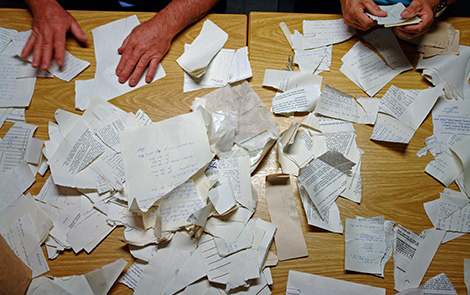In 1989, when the famous Berlin Wall that separated East Germany and West Germany fell, East Germany’s Ministry of State Security, the Stasi, which was known for secret police agencies in the world, decided to destroy all the important documents which had vast secret information documenting evidence of spying on West Germany for 40 years. When they used the Stasi’s shredder machine to destroy all documents, unfortunately for them, it broke down soon after they started. When they had to destroy this evidence at any cost, they employed their agents to destroy the documents by tearing apart the records into 600 million pieces. However, the Stasi document shredding didn’t work. They had 16,000 garbage bags stored in the basement of security headquarters with evidence that was shredded into tiny pieces of paper.

Source: Die Behörde des Bundesbeauftragten für die Stasi-Unterlagen
There is now a new machine called e-Puzzler that runs with software that is used to compile sophisticated pattern recognition technology. Scientists plan to use this technology to put together all the shredded Stasi files which were considered gone and lost forever.
At first, the lost documents were manually reassembled with the help of a team of 45 civil servants back in 1991. They worked hard to put around 90,000 pages together with the help of Scotch tape. Those lost papers began to reveal the Stasi collaborators and their victims. However, in August 2009, the team had narrowed down to only eight people, but they had completed only 350 bags. With that number of people who were trying to compile those documents, it would take them another 800 years to complete all the bags.
Nobody thought it was possible to do it manually until the idea of getting the work done by a machine came about when scientists at Berlin Fraunhofer Institute of Production Facilities and Construction Technology were successful in developing the magnificent machine called the e-Puzzler.
That’s how e-Puzzler works:
The e-Puzzler is a computerized machine which has a conveyor belt that feeds around 10,000 shreds of paper with the help of a document scanner. After the papers are fed into the e-Puzzler for document scanning, the software starts to search by looking for similar attributes like color, typeface, and texture from shreds of papers. It is much like a person solving a puzzle with many pieces of solutions. When the processing of information is completed, the machine displays the final output of a reconstructed image of the document on a screen.
The lead inventor of the e-Puzzler, Bertram Nickloay says “We demonstrated back in 2007 that we can match smaller amounts of document shreds,” He says “Our task is now to make the technology applicable for huge masses of data. The biggest challenge is the scanning technology – we are working on the cutting edge of what is possible in that field.” But even after the documents are put back together, it could take years before we understand their place in history. “Once assembled, the digital pages need to be reviewed for plausibility before the Stasi record office can even start to reassemble files and folders from the reconstructed pages, let alone study and process the information,”
Now even the government is planning to fund $8.5 million for the e-Puzzler project by next year. Then the German parliament will think about how many funds will be given to continue the project in the future, in 2012.
Germany’s history will have a strong impact once the e-Puzzler starts to reveal all the secrets, including the names of the spies. It has nearly been 20 years since the wall broke down, but if the evidence in documents starts to reveal the names of people who could now be working as lawyers, sports coaches, and even newspaper editors, they could all be in serious trouble. Even the people who were suspected of being spies back then would have to prove their innocence after 20 years. All information will be revealed once the e-Puzzler will slowly start to unravel the truth. Even Nickolay wants to find out the truth behind his friend Jürgen Fuchs imprisonment, a leading GDR opposition member, who later died of leukemia due to being exposed to radiation when he was in prison. Nickolay says this machine will give us clues about who was responsible behind all this for all this.
Joachim Häussler, the head of a government agency, says the world has a chance to look back at history and know the real facts behind those dark years of Germany. History will no longer be hidden and, with one small piece at a time, we will discover the truth that we thought had been destroyed a long time ago.

